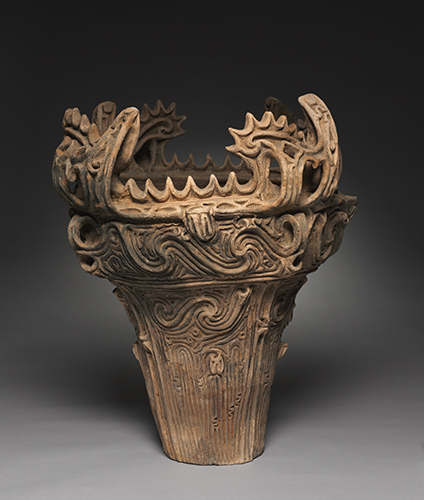World's Oldest Ceramic Vessels: Jōmon
Most people think of ancient Greek painted ceramic vessels when you mention the word “ancient pottery.” What I think of are the sophisticated, elegant, and beautiful ceramic vessels of one of the oldest cultures in the world in Japan, the Jomon Culture.
 |
| Japan, Jōmon Period, Storage vessel, ca. 2500 BCE. Earthenware with carved and applied decoration, 24" x 22" (61 x 55.8 cm). © Cleveland Museum of Art. (CL-448) |
Did you know that Jomon vessels, which were discovered in the 1800s, are the oldest ceramic vessels (not objects) in the world? The Jomon people had a continual culture that is believed to date back as far as 11,000 BCE and lasted until the first millennium BCE. Most Paleolithic, Mesolithic, and Neolithic cultures developed sophisticated ceramic and other art forms after becoming agricultural communities. The Jomon developed agriculture very late, and remained primarily a hunting-fishing, food gathering culture throughout their long existence. This makes the sophistication of Jomon ceramic vessels particularly interesting. Archaeologists generally consider the period 3000–200 BCE to be the height of the Jomon culture.
The Jomon vessels are coil-built pots decorated with incised or applied decoration. The very term “Jomon” means “cord pattern,” referring to the common decorative motif seen on vessels from the Middle Period (ca. 2500–1500 BCE). This vessel, from the Middle Period, is termed “flame-style” because of the exuberant decoration of the rim. Jomon potters seem to have delighted in exploring a wide range of decorative effects totally unrelated to the intended use of the vessel. This would mean the Jomon ceramics were the first vessels in history designed on an aesthetic basis comparable to the utilitarian.
Cone-shaped vessels such as this one may have been stuck into the soft sand and used for cooking food. They were also used for storage in burials. It has been hypothesized that Jomon vessels were made by women, as were many ceramics in early human societies.
Connections Across Curriculum - As the study of artifacts, archaeology gives students an opportunity to explore the world around them. Art, history, and science come together to give students a hands-on learning experience. Activities can include visiting a museum or National Park or interpreting objects in the classroom. The National Park Service “Archeology for Kids” website provides information, activities, and resources for educators.


Comments